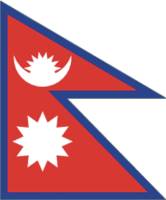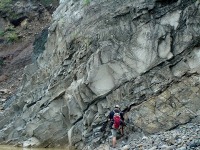Special Program for International Students
GRADUATE COURSE IN EARTH SCIENCE
& GEOENVIRONMENTAL SCIENCE
Current MEXT students
Swostik Kumar Adhikari (Nepal)
Email: s129311@matsu.shimane-u.ac.jp
Thesis title: Fluvial system reconstruction of the Siwalik Group along the Khutia Khola area and its relation to the paleoclimate and tectonics of Himalaya, far western Nepal.
Supervisor: Assoc. Prof. Tetsuya Sakai (2012-2014).
The Miocene Siwalik Group is exposed near the foot of the Himalayan Mountains, forming the southernmost hill range with width of 5 to 6 km. The Siwalik Group consists of fluvial deposits (16 Ma to 1 Ma) that were strongly influenced by the Neogene tectonics of the Himalaya. The Siwalik deposits are thus important archives of the Himalayan uplift, and related climatic changes.
The Siwalik Group in the Nepal Himalaya is subdivided into three or four lithostratigraphic units. Several previous sedimentological studies of the Siwalik Group have revealed a change in the fluvial succession from meandering stream to braided stream deposits. In these facies changes, the appearance of flood flow dominated meandering stream deposits records frequent flood deposits on the flood plain. This increase in water discharge is a good indicator of increased precipitation. The timing of the appearance of such facies differs between areas, however. Although the appearance of this facies is important for identifying climatic changes associated with Himalayan Uplift and at a global scale, the reason for the diachronous change is still under debate.
My target is the Khutia Khola, which lies in the far western Nepal. No sedimentological study has been done in this area to date, but magnetostratigraphic data is available. I will examine facies changes in the Khutia Khola section, and compare facies changes in the nearby Karnali River section and other Siwalik successions, to investigate the cause of the changes within them.
Objectives
- To prepare a detailed lithostratigraphic map of the Siwalik Group in the Khutia Khola area.
- To study and reconstruct the paleoenvironment of the Siwalik fluvial system, based on sedimentary facies analysis.
- To determine changes in sediment provenance based on petrographic study and whole-rock geochemical analysis by XRF.
- Finally, identify the change of the fluvial system during deposition of the Siwalik sediments, and its relationship with paleoclimate and tectonics of the Nepal Himalaya.


